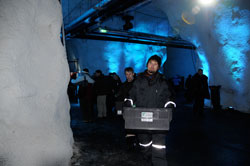In 2002, the world’s governments agreed to significantly slow the rate of biodiversity loss by 2010. Time is almost up, and by most accounts they’ve failed. Now that climate change is emerging as one of biodiversity’s greatest threats, scientists are proposing new ways to tackle the crisis. In the latest, and last, issue of Nature Reports Climate Change, Hannah Hoag reports on some of the most promising efforts underway to protect biodiversity against rising temperature and other impacts of climate change.
In short, they are:
1. Barcoding life
Paul Hebert, an evolutionary biologist at the University of Guelph in Canada, devised a method for DNA barcoding in 2003, thus speeding up the process of taxonomy. Before barcoding, biological specimens were identified on the basis of morphology, behaviour and genetics. The technique, which allows for rapid species identification, offers a “quantum jump” in the rate that species are registered, says Hebert. It also gives biodiversity a boost: barcoding has repeatedly shown that one species is, in fact, three, or ten. The hope is that as the technology evolves, scientists will be able to use hand held barcoders to identify changes in a region’s biodiversity.
2. Backing up biodiversity
The Svalbard Global Seed Vault in Norway, opened in 2008, is the ultimate insurance policy against the loss of the world’s crop genetic diversity. More than 522,000 seed samples from around the world are stored at −18 °C within the subterranean facility, like safety-deposit boxes in a bank. Most of today’s crops have been carefully bred for traits that fit the present climate, so as temperatures rise, crop production is likely to be negatively affected in many of the world’s most agricultural regions. One study concluded, for example, that with a 2 °C temperature rise, more than 80 per cent of the land area over most African nations would be climatically unsuitable for the crops now growing there. If such projections become reality, the seeds contained in the Svalbard Vault could be used to breed new varieties of crop containing traits for drought tolerance and such like.

3. Putting a price on nature
The Cauca Valley, a region in the southwest of Colombia sandwiched between two Andean mountain chains, is the site of a major water fund project involving of reforestation, water protection, soil improvements, education and training. By investing in the region’s ecosystem services, the project aims to lessen climate change impacts and threats to biodiversity.
Although water funds exist globally to conserve watersheds, this is one of the first to include climate change modelling to help direct investments. Climate change projections are fed into a computer-based decision-making tool called InVEST, which has been developed by the Natural Capital Project, a partnership between TNC, Stanford University and the World Wildlife Fund. InVEST identifies the areas where climate change is unlikely to threaten activities the water fund has been invested in — such as promoting the reforestation of a hillside or teaching eco-friendly cattle-ranching practices — and their returns. By directing investments wisely, the region can benefit financially as well as adapt to climate change.
4. Shifting species
Efforts are already underway to relocate species that simply can’t keep pace with climate change. These have been few so far, but they may become more common if biologist Camille Parmesan of the University of Texas at Austin has her way. Parmesan is suggesting the US Fish and Wildlife Service use managed relocation to save the Laguna mountain skipper, a small, black-and-white endangered butterfly found on only two or three mountaintops in southern California. Though assisted relocation could help species adapt to climate change, some fear that the risks – such as introducing invasive species to a region – outweigh the benefits, and others warn that it’s a short term solution at best. But, says Parmesan, “there is no no-risk option.”
5. A moveable park
Traditional conservation approaches assume that species ranges will always stay in the same place: if you protect the geographic region, the species within it will be protected forever. But species don’t stay put when temperatures move outside their comfort range. To deal with this dilemma, Lee Hannah of Conservation International has recently suggested using moveable conservation parks within the ocean. Such mobile protective areas could help to conserve species such as the loggerhead turtle, says Hannah.
6. An IPCC for biodiversity
Come June, biologists and policymakers will gather in South Korea to discuss the future of a proposed scientific panel to monitor biodiversity and offer advice on its protection. Like the IPCC, the Intergovernmental Platform on Biodiversity and Ecosystem Services (IPBES) would improve the links between science and policy, and ensure policy decisions are based on the best available science. It would oversee global and regional biodiversity assessments, identify and analyse trends, and explore future changes. It would also invest in training.
The full article is freely accessible here.
Image: Boxes of seeds arrive from around the world to the Svalbard vault. GLOBAL CROP DIVERSITY TRUST
Report this comment
I like the idea of moveable parks.
Needed on land as well, I fear.